Forum Replies Created
-
AuthorPosts
-
 Robin LeadbeaterParticipant
Robin LeadbeaterParticipant01-01-21. Same as with the new millenium. Since the first day of the Common Era was 1st Jan 0001 the 3rd millenium began 1st Jan 2001 but you probably will not convince the billions who celebrated the year before or similarly convince them that the new decade starts next year
 Robin LeadbeaterParticipant
Robin LeadbeaterParticipantHere is the latest Atel on the subject
http://www.astronomerstelegram.org/?read=13410
“The recent changes defined by our V-band/Wing photometry seem best explained from changes in the envelop-outer convection atmosphere of this pulsating, unstable supergiant. If these recent light changes are due to an extra-large amplitude light pulse on the ~420-day period, then the next mid-light minimum is expected during late January/early February, 2020. If Betelgeuse continues to dim after that time then other possibilities will have to be considered. The unusual behavior of Betelgeuse should be closely watched.”
 Robin LeadbeaterParticipant
Robin LeadbeaterParticipantI am now picking up some evolution in my spectra since the start of the year. The relative flux around 7500A has been increasing compared with that at 5500A. This is consistent with the brightness in V dropping more than in the IR
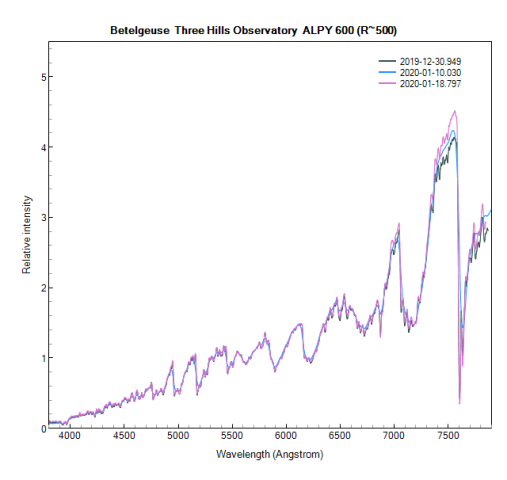
 Robin LeadbeaterParticipant
Robin LeadbeaterParticipantThese could perhaps be a source for content for the more general articles on the website or worked up into articles or even peer reviewed papers for the Journal, a sort of informal BAA arXiv ?
 Robin LeadbeaterParticipant
Robin LeadbeaterParticipantThanks Andy,
I was thinking it might be interesting to use the personal page like a blog, text images and graphics covering particular topics. (Similar to the BAA articles but in the personal pages.) A combination of the quick post and the image submission functions which don’t quite fill this need individually. Opening up the quick post function to include graphics would do this I think. Is this something that might be considered for the future?
Cheers
Robin
 Robin LeadbeaterParticipant
Robin LeadbeaterParticipantI notice there is no direct access to member pages from the website when not logged in but they are accessible if the link is known eg
https://britastro.org/profile?id=146
https://britastro.org/node/20453
Is this intentional or just the way it works ?
Robin
 Robin LeadbeaterParticipant
Robin LeadbeaterParticipantFinally a clear night last night so was able to take a low noise spectrum at R~500 using the ALPY 600. Using SNID gives an exquisitely good detailed match to several Ia supernovae still a few days from maximum (black is my spectrum red is best match from SNID
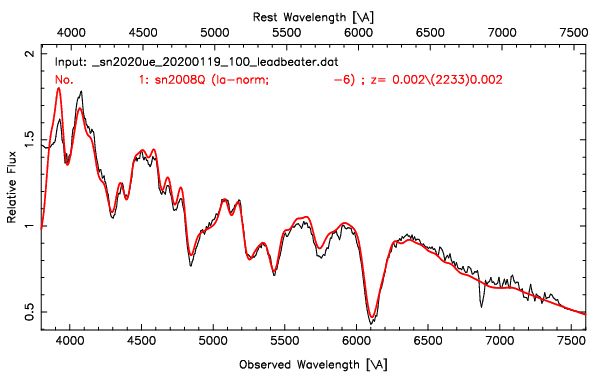
Cheers
Robin
 Robin LeadbeaterParticipant
Robin LeadbeaterParticipantA low resolution spectrum from last night. Mainly scattered sunlight but once divided by a nearby G2v solar analogue star spectrum the emission features can be identified. CN at 390nm in the UV is particularly strong.
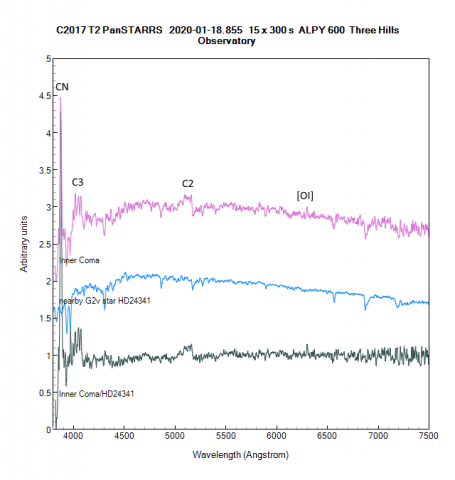
The raw spectrum image can be seen here
https://britastro.org/node/20453
Cheers
Robin
 Robin LeadbeaterParticipant
Robin LeadbeaterParticipantCurrently mag 12.8 as measured by Itagaki compared with his 14.9 discovery magnitude
 Robin LeadbeaterParticipant
Robin LeadbeaterParticipantYep that was my starting point of course but they are outside the spectrograph guider field.
Cheers
Robin
 Robin LeadbeaterParticipant
Robin LeadbeaterParticipantI don’t do anything currently. I visually examine each exposure and cannot recall seeing anything that I could put down to a satellite. The satellite will not spend long in the slit though so the contribution could be too small to be obvious, just contributing to the uncertainty. They would be more likely to appear in the wider sky background subtraction zones so hopefully the median averaging across the zone deals with them there.
 Robin LeadbeaterParticipant
Robin LeadbeaterParticipantThe potential effect on spectroscopy is an interesting one as unlike photometry where trails will be obvious in the image, the cumulative contamination from the trails briefly crossing the slit during say a 20 min exposure, either within the binned or background subtracted regions may not be so obvious.
 Robin LeadbeaterParticipant
Robin LeadbeaterParticipantI did some years ago with a simple setup
http://www.threehillsobservatory.co.uk/astro/spectra_20.htm
but these days in the BAA at least Bill Ward would be the guy to talk to eg
 Robin LeadbeaterParticipant
Robin LeadbeaterParticipantIt does indeed seem the fading of Betelgeuse has indeed been greatly exaggerated
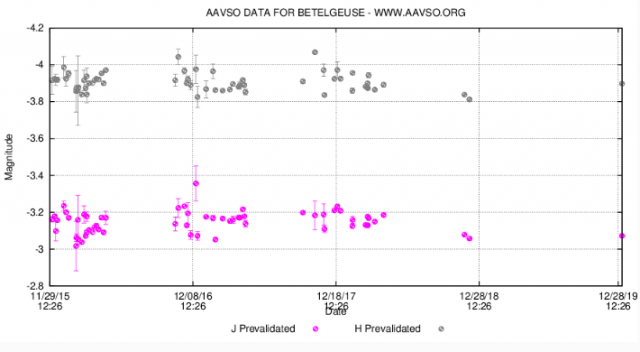
I see there is now a recent H,J point in the AAVSO database (The first for over a year)
It shows that Betelgeuse is not fading in the IR where most of the flux is so it does suggest there has not been any significant drop in bolometric luminosity, just a small drop in temperature which has produced an exaggerated effect at V mag, a region sensitive to changes in the depth of the molecular absorption bands.
Cheers
Robin
 Robin LeadbeaterParticipant
Robin LeadbeaterParticipantThe latest Atel from the team who originally announced the dimming has some figures on photosphere temperature changes based on IR Wing band filters. They seem to tally reasonably with our estimates from the spectrum change
 Robin LeadbeaterParticipant
Robin LeadbeaterParticipantHi Andy,
Good point. The V (and R) band does seem to sit in a region which is particularly sensitive to the degree of molecular band absorption which in turn is sensitive to temperature. That additional absorbed flux has to end up elsewhere in the spectrum, most likely in the IR so changes in V mag probably do overestimate the change in total flux as you say.
 Robin LeadbeaterParticipant
Robin LeadbeaterParticipantHere for example is a comparison of standard spectra for M2iii (blue Teff 3600K) compared with M6iii (pink Teff 3100K)
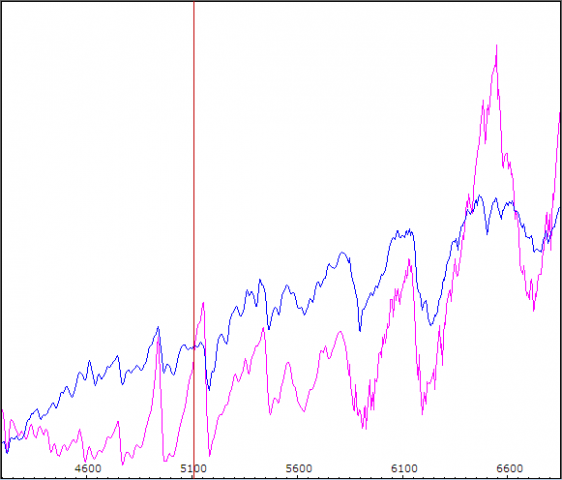
 Robin LeadbeaterParticipant
Robin LeadbeaterParticipantNo the individual lines cannot be resolved (Even if the spectrometer had enough resolution they would be broadened in the stellar spectrum to the point where they merged). The depth of the merged bands however gives a measure of the spectral class and therefore Teff even in low resolution spectra. The referenced Atel for example just used photometry in a particular targeted 705nm waveband to estimate the temperature change.
“Measures of Wing TiO-band (705 nm) and near-IR colors indicate that currently Betelgeuse has relatively strong TiO-bands and has a corresponding lower photospheric temperature of T~3580 K (relative to T~ 3660 K near maximum brightness”
 Robin LeadbeaterParticipant
Robin LeadbeaterParticipantWein’s law is not too much help here as we are seeing just the tail of the black body distribution and stars like these are not really black bodies in any case due to the contribution of the deep absorption lines which varies with temperature
Looking at the Pickles standard spectra (see attached) The change in Betelgeuse looks to correspond to a change in spectral class of around 1-1.5 points eg M2 to M3.5 That is equivalent to a drop in Teff of around 200-300K
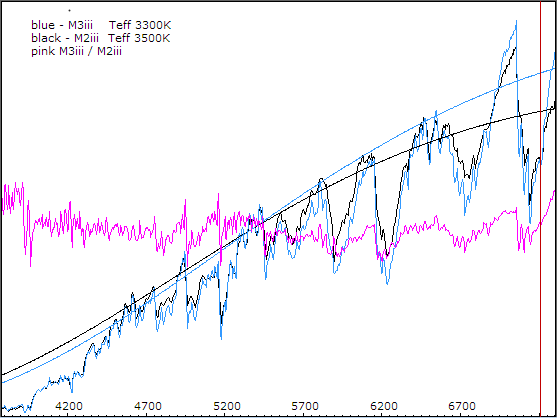
 Robin LeadbeaterParticipant
Robin LeadbeaterParticipantThe implication is that the contraction in this case could be the result of a reduction in energy production rather than the normal radial pulsation cycle. I am not convinced yet that we are in that situation though rather than the coincidence of the combined effect of the normal pulsations with different periods. If it keeps dropping though….
-
AuthorPosts
